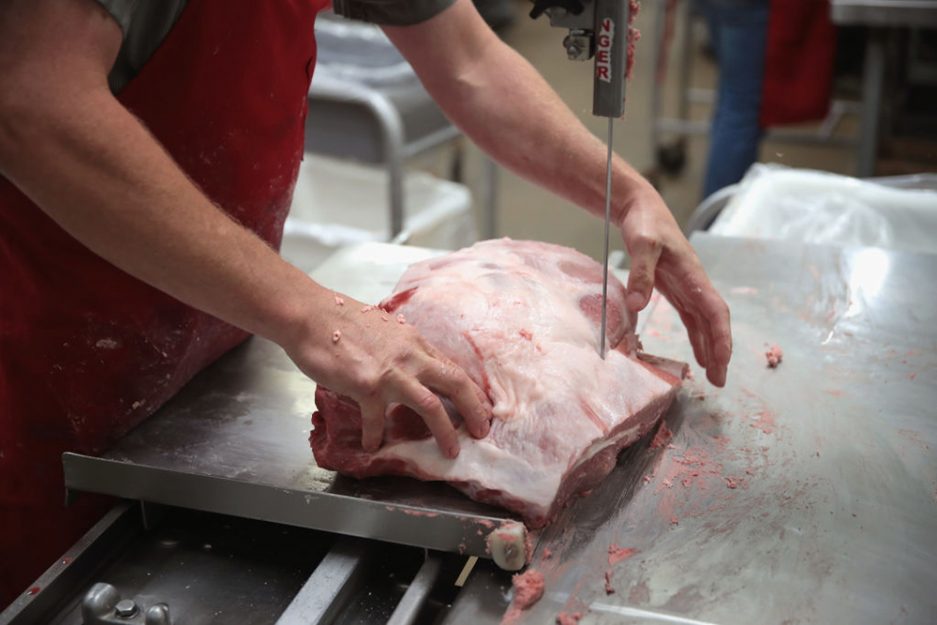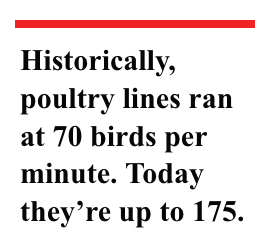Talk Poverty: Meat Processing Is A Dangerous Job. It’s About to Get A Lot Worse.
by Claire Kelloway | April 24, 2019
About three and a half seconds. That’s how long inspectors currently have to check a pig carcass for lesions, hair, infected organs, or fecal matter before it’s sent whirring to workers, who slice up the roughly 250-pound animals in a freezing room, side by side, for eight to 10 hours a day, churning out more than 1,000 pigs an hour.
If a new pork inspection rule recently highlighted by the Washington Post passes next month, the lines will run even faster and plant employees will have to take responsibility for this visual inspection, putting workers and eaters at risk.
Though this might sound like another Trump-era regulatory rollback, it’s actually the final step in a drawn-out food safety debate that’s spanned four administrations.
The changes are part of a double-acronym mouthful, the Hazard Analysis and Critical Control Point (HACCP)-Based Inspection Model Project (HIMP). These new inspection methods have been quietly piloted at a select number of pork and poultry plants for some 20 years, with the basic goal of reducing USDA inspector spot checks and moving more safety testing offsite. Big meatpackers and the U.S. Department of Agriculture Food Safety Inspection Service claim these “modernizations” will improve safety and address inspector shortages, without harming workers.
But accounts from workers and investigations by government watchdogs and advocacy groups tell the opposite story. By speeding up processing lines and allowing meatpackers to police themselves, HIMP plants pose serious risks for food safety and increase already hazardous working conditions.
While the Trump administration faces blowback for giving plant employees greater oversight of hog slaughter, the Obama administration passed similar food inspection changes in the poultry industry in 2012, known as the New Poultry Inspection System.
These changes shift some duties from federal food safety inspectors to plant employees. Previously, federal inspectors visually checked every chicken or hog carcass for things like infected organs, fecal contamination, and other signs of diseases or defects. The new systems put plant employees in charge of those checks. For pork, large plants currently must have seven USDA inspectors; under the new rules, they would have three. For poultry, the number of required USDA inspectors shrunk from four to one.
USDA and industry groups often say that the HIMP pilot programs in both pork and poultry have proven just as, if not more, safe than the current system. But additional accounts suggest otherwise.
A 2013 inspector general report argued that the USDA “did not provide adequate oversight” of the HIMP pork pilots, and that the agency could not determine whether the pilots improved food safety. In fact, the inspector general said “HIMP plants may have a higher potential for food safety risks.”
The advocacy group Food & Water Watch also uncovered that the new salmonella testing program was flawed for all poultry plants prior to a protocol change in July 2016, bringing the HIMP poultry pilot findings into question as well. The group also obtained inspection documents for 14 HIMP pilot poultry plants through a Freedom of Information Act request, and found widespread instances of company employees routinely missing defects.
Politico reported that several poultry plants enrolled in the new poultry processing program have already failed necessary food safety testing to increase their line speeds. Food & Water Watch also revealed that these poultry plants also “fail the agency’s salmonella performance standard at a greater rate than those that have not opted into the new system.” In fact, one of the original poultry pilot locations operating at faster line speeds was forced to suspend operations in May due to food safety violations.
When it comes to pork, there are only five HIMP pilot plants, but of the top 10 pork plants nationwide with the most food safety violations, three participated in HIMP. This includes the worst performing plant, which racked up nearly 50 percent more citations than the next most dangerous plant over the course of three years.
More fundamentally, having plant employees check carcasses amounts to self-regulation and presents a clear conflict of interest. Simply put, plant owners profit more the less they stop the line, making them more reluctant to address quality concerns than federal inspectors. In a public comment, one concerned USDA inspector said, “the bottom line is that a company is out to make money and they can not do that if the line is not running. Even if it means letting something go down the line and ultimately out the back door that is not fit for human consumption.”
“If this proposal goes through and inspectors are cut, I would not feel safe enough to feed [poultry] to my family,” she added.
When a handful of powerful meatpackers ramp up line speeds, the risks extend beyond food safety to the workers who face the physical toll of processing more animals in less time.
As it stands, the USDA only assesses line speed increases for food safety outcomes. The agency is quick to note that it does not have jurisdiction over worker safety, and that the Occupational Safety and Health Administration (OSHA) protects workers. But OSHA has been derelict in its duty to prevent workplace injuries directly tied to increased line speeds.
While OSHA has set maximum operating speeds in some industries, such as grain processing, it has not done so for meatpacking. In fact, OSHA denied a 2013 petition requesting that the agency set slaughterhouse speed standards on the grounds that it did not have the resources to study the issue.
In absence of worker-safety informed limits, line speeds continue to increase. Historically, poultry lines ran at 70 birds per minute. Today they’re up to 175, after the poultry industry petitioned the Trump administration to revoke an Obama-era decision to keep the speeds at 140. The new pork rules would lift processing speed limits entirely, and the Post reports that line speeds could increase from 18 hogs per minute to 20. In four independently conducted surveys by the Southern Poverty Law Center, Midwest Coalition for Human Rights, Nebraska Appleseed, and Human Rights Watch, workers cited increased line speeds as the top or most notable complaint in regard to workplace safety.
According to the Department of Labor, meat processors get injured five times more frequently than other workers, and are nearly 20 times more likely to develop carpal tunnel syndrome. True injury rates are likely even higher: Another study by the Government Accountability Office found that federal data likely does not capture all meat processing injuries, especially because immigrants and refugees, who comprise 28 percent of meatpacking workers, are less likely to report injury or workplace misconduct due to fear of retaliation or deportation. OSHA also admits that workers with limited English proficiency “often do not get the necessary safety training on the job and do not know their rights under the OSHA law.”
No matter how you slice it, faster line speeds line meat processors’ pockets at everyone else’s expense. Their costs per animal go down the faster lines run, churning out more product per worker and per plant. The one leg meat corporations have left to stand on is the argument that they’ll pass their savings onto consumers, but recent price fixing cases prove those talking points are hogwash. The only real winners are corporate packers and their shareholders, while workers and eaters pay the price.

